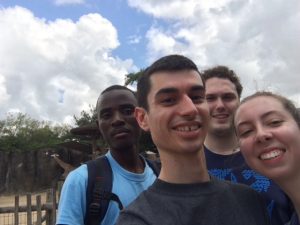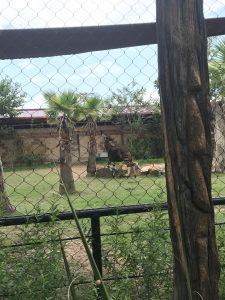When I arrived at the OEDK on Monday for the first day of SEED, I had already guessed what we would do first: icebreakers. We played an assortment of fun get-to-know-you games, including my personal favorite, “Question Ball” (with questions such as “ALIENS?!” and “What is your second favorite holiday?”). It was nice to get to know everyone, especially since I didn’t know very many people well, but it was especially cool to get to know the international students from Malawi and Brazil since their cultures differ from our culture here in the US. Later that day we walked to the zoo for a scavenger hunt that would help us get to know each other better, and saw some fantastic animals, such as my new personal favorite, the pinecone fish.

Most of the SEED interns before our scavenger hunt at the zoo. One group was so determined to win that they began their scavenger hunt before we could even take a photo!
Day two of SEED started with more icebreakers but quickly got into information and overviews about the program. We took a tour of the OEDK, learned about safety at the OEDK, and heard a presentation about safety in the US. That morning, we did an activity called “deconstruction” in which we took apart machines to see how they worked. My group (mistakenly) chose a printer to take apart. We began by gently trying to undo the screws and pop off parts, but quickly learned that the most effective method for taking apart this printer was to forcefully tear off any part that felt the slightest bit loose.
On the third day of SEED, we started our “boot camp”. During boot camp, we are very quickly going through the engineering design process. Our project for boot camp is to make an enrichment device for the Okapi at the Houston zoo. Each night we watch videos and learn about the next few steps of the engineering design process. Then, at work the next day, we practice each of these steps both with an example project and with our Okapi enrichment project. For instance, after the second day of SEED, we learned about the first few steps in the engineering design process, such as clarifying the team assignment and understanding the problem and context. Later on day three we went back to the zoo to learn more about Okapi enrichment and speak to the hoofed animal zookeeper that is responsible for caring for the Okapi. We also went behind the scenes at the Okapi exhibit to see the current enrichment devices that the Okapi have.
On the fourth day of SEED, the second day of boot camp, we finished our research and completed our design context review for the Okapi enrichment project. We then made some design criteria based on the interview that we had conducted with the zookeeper and the research we had completed. The two design constraints that we made are safety and size, as the enrichment device will not be successful if it is not safe for the Okapi or if it does not fit into the designated storage space. We also brainstormed. My team, Team Elephant (Caz, Christopher, Jake, and I), ended the day with 36 complete ideas for a new Okapi enrichment device!
The first week of SEED has been busy and fun, and I look forward to the rest of the internship, especially finding out next week what project my team will be working on for the rest of the summer. Next week we will complete boot camp on Monday and Tuesday. Hopefully by that time we will have some promising ideas in the works for the Okapi. Starting on Wednesday, we will begin our summer-long projects! I can’t wait to see what the rest of the summer will be like and what we will accomplish.





Love this blog Kalen! I’m looking forward to seeing what your team comes up w/ for the okapi. Mere written words cannot describe how excited I am you are working on this project for these animals! 😍